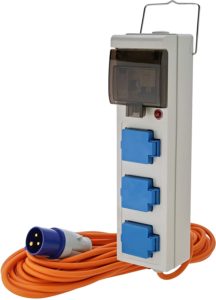NEWGALE CAMPSITE
Guidance for use of Electrical Hook UPs
Please use our electric hook-up facility safely and efficiently.
Our electric hook ups provide a 230V supply but electricity is restricted as our hook-ups are either 10 or 16AMPs (please check the AMPs noted on the post where you connect your lead or on your booking summary).
Please be careful what you use to avoid ‘tripping out’ the system.
The main site power supply is geared up to an average electrical usage assuming not all hook-ups take all AMPs at any one time.
Occasionally, if a cold spell occurs at times of high occupancy and all users switch on electrical heaters, kettles etc. at the same time, you may suffer reduced power or even a power cut, so it is important to use electricity responsibly.
KNOW YOUR LIMITS. You will need to think about the equipment you want to use on site. At home you’ll probably have plenty of sockets and it’s rare to overload them but a campsite socket can be easily overloaded. If you are on a acampsite with a 10A supply like ours, you will have around 2.3kW available. That means you could run a low watt camping or travel kettle (around 750 Watts) plus a low watt toaster (900 Watts). If someone then plugs in a low 600 Watt hair dryer you are dangerously close to tripping the electrics. Of course, not all appliances are the same so the best thing to do is add up all the Watts of the appliances you want to use at the same time, and make sure it stays below the amount of Watts (2.3kW) available from our electric hook-up supply. Don’t forget that 1 kW equals 1000 Watts. A high speed kettle from home may be 3KW!
Tripping the electrical supply can make you unpopular on site. If your electric supply does trip, please check the trip switch on your post, ensure it is on. If this has not tripped, contact site reception or call us on 07539 906611 to reset the system.
Follow these tips below and take professional advice from your equipment supplier to ensure your camping trip is safe and comfortable!
- SAFETY FIRST. We are responsible for the safety of our electrical supply equipment up to the socket outlet on the hook-up bollard and have it tested on a regular basis but you are responsible for the safety of your hook-up cable and your unit’s electrical installation. However, we have overall responsibility for the safety of our guests while on site so if we feel that any electrical equipment does not conform to safety standards or is connected to the supply in an unsafe manner, we will disconnect the camping unit.
- LEAD. You must use a purpose-built lead designed for bringing electricity to your unit. These leads will have special weather-proof plugs made to connect to the sites hook-up.
TENTS & USE OF ELECTRICAL HOOK-UP
When pitching on an EHU with a tent you will need to have a special hook-up device manufactured specifically for tent hook-ups.
These will have two or more damp-proof sockets, each of which will take an ordinary 13A plug the same as you use at home. One of the reasons for using a properly designed electrical connection to your unit is that a Residual Current Device (RCD) safety device will be wired into the circuit. This is designed to cut off the supply immediately in the case of a leakage of current to earth. This can occur when someone touches an appliance that is damp, particularly if the person is standing on damp ground. The device will also have a Miniature Circuit Breaker (MCB) to protect from overload.
 Amazon ASIN B004DV6UXS approx £30.
Amazon ASIN B004DV6UXS approx £30.
- CONNECTING. When you are ready to connect, make sure your RCD on your unit is in the off position, then connect the lead to your unit and finally plug in to the hook-up point. That way you avoid carrying a ‘live’ lead to your unit. Test the RCD by switching it on and pressing the test button on the unit. If it fails to operate it is not safe to use and you will need to get it checked by a suitably qualified person.
- WATER AND ELECTRICITY. Tents can be damp and moisture and electricity do not mix. The socket end of the cable will usually have some means of fixing it well above ground level. Don’t use electrical equipment on the tent floor as leaks or condensation could lead to dampness.
- SWITCHING OFF. Finally, when you are ready to leave, switch off your unit’s RCD, disconnect the cable from the hook-up bollard and lastly, remove the cable from your unit. If you are in a motorhome or campervan and are temporarily off site, you must unplug your lead from the hook-up point first so that a ‘live’ lead isn’t left on the ground.
- Never leave appliances running in an unoccupied tent, or when you go to bed.
- Don’t overload your socket box. Use only one appliance per socket, and multi plug adaptors are a definite no-no.
- Please check your hook up post or booking summary to see what the amps are for your pitch.